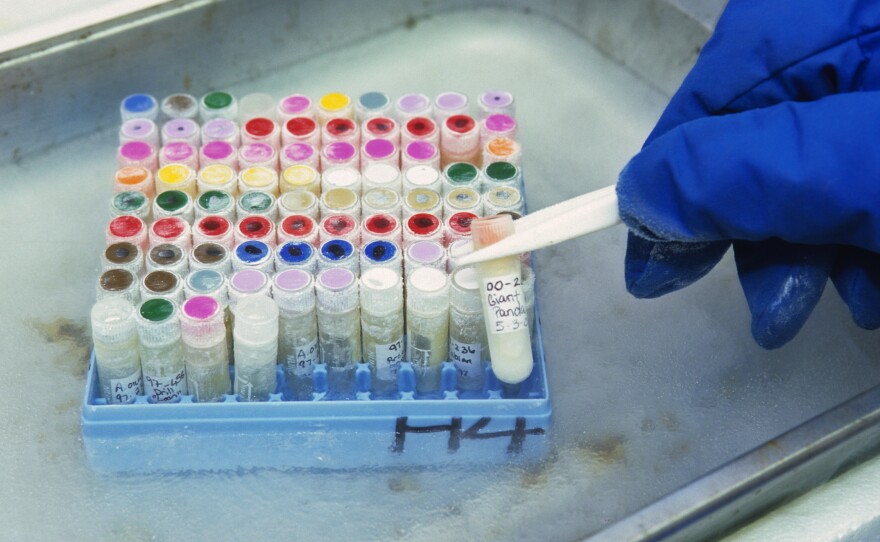With its voracious velociraptors and terrorizing, Jurassic Park 20 years ago introduced movie-goers in spectacular fashion to the idea of bringing species back from extinction.
The movie introduced the idea of mosquitoes containing the blood — and thus the DNA — of dinosaurs preserved in hardened amber for millions of years, providing the genetic blueprint for bringing the monsters back to life.
It was effective movie-making, though real science wasn't quite ready back then. But now a couple of San Diego scientists are involved in a national discussion that could lead to the revival of an extinct species.
Researchers have developed enough tools that the idea of reviving an extinct species isn't so far fetched. And, as depicted in the movie version of Jurassic Park (and book that preceded it), revising extinct species presents serious ethical concerns.
Oliver Ryder is a geneticist at the San Diego Zoo. He looks after, arguably, the zoo's most valuable collection.
Ryder explained as he entered a cool, windowless room far removed from the crowds taking in the baboon, elephants, rhinos, tiger and bird exhibits at the zoo.
"So this is the room that holds the tanks that comprise the frozen zoo. This one holds the living cells that are in suspended animation," he said.
Ryder lifted the cover off one tank and a cold cloud of fog rolled over the edge. Inside, nitrogen keeps tissue samples from about 10,000 individual animals frozen. They represent about a 1,000 distinct species.
"Here's a species that's gone extinct. And that's not what we want to see happen as conservation biologists,” Ryder said.
“If there's one thing you could save, it would be living cells. Cells are fundamental units of life. They are able to replicate themselves. All organisms start their lives or live their lives as a single cell."
Each cell contains a complete genetic blueprint. Rider said these tanks hold the potential to change the evolutionary path. Right now, the collection only has tissue from one extinct species, a bird from Hawaii.
But it might be the only hope for another species that is rushing headlong toward extinction.
"We have cells from 12 northern white rhinos, here. There are only seven alive on the planet. We have their cells and we have cells from unrelated individuals and their parents that (died before) them."

Ryder said those cells could be the key to keeping the rhinos alive, or even bringing the species back after the remaining animals die.
That's territory Michael Mace is familiar with. Mace, the Zoological Society's curator of birds, helped the California condor fly away from extinction in the 1980's. That 22-bird condor population now contains more than 400 birds.
"If we're working with species like condors that have a very finite gene pool, or black-footed ferrets, or mountain yellow-legged frogs, the ability to recruit genes from museum specimens for example, could change the playing field genetically," he said.
Tapping into a new source of genetic code would be like finding an undiscovered population. It increases genetic diversity and boosts chances for species survival.
"You are having advances in science that are starting to have the real possibility,” Mace said.
“We have a planet that every day another species is lost. And so people are starting to put those concepts together and say, ‘we've got critically endangered species declining, we've got ecosystems that are disappearing and do we have the technology to stop some of those big concerns and issues that are affecting all of us?’ "
But propping up a species on the brink of extinction isn't as controversial as raising a species from the extinction pile.
"Mastadon, mammoth, other types of species … it's a very complex science to be able to do that,” Mace said. “It’s an even more complex and compelling discussion about whether one should."
That discussion is holding a prominent place in the world of science and ethics. Suzanne Holland, professor of religion at the University of Puget Sound, is skeptical about the idea of reviving extinct species.
"I would like to hear a good reason for doing it, other than because we can do it,” she said. “There are lots of things we can do, that we perhaps ought not to do."
Holland is not sure lifting the stamp of extinction is good for people or the planet.

"We have critical health care needs, we have critical scientific funding needs. This does not seem to be, as far as I can tell, at the top of any list to the benefit of humanity," she said.
But the argument isn't being waged with absolutes, and even Holland says there could be legitimate reasons.
A potential candidate for “de-extinction,” as it’s called, is the passenger pigeon. Once the most abundant bird in the world, it was hunted out of existence in the 1800s.
Geneticist Oliver Ryder said some scientific issues still need to be worked out, but many tools to implement de-extinction are already in place.
"The ability, the possibility, of cloning has been around for over a decade,” Ryder said. “The possibility to induce pluripotency, that is to make skin cells into stem cells, has been around for four or five years. What's energized this discussion has been bringing back extinct species.”
The science may be catching up with the science fiction. But researchers are still debating the ethics of de-extinction. That discussion will more than likely write the story.






